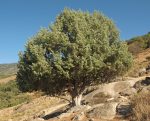 Also known as cade, cade juniper, prickly cedar, and sharp cedar this coniferous evergreen is native to rocky sites in the Mediterranean region from Portugal and Morocco, to southern France and east to parts of Iran, Lebanon and Israel. It is a member of the cypress family, Cupressaceae, that also includes arborvitae and redwood. The plants are variable and some authorities divide it into 3-4 species. It can be a spreading shrub 6-10′ tall or a small tree up to 50′ tall and has a bushy, irregular crown, spreading to upright branches with drooping tips, and thin gray bark that peels into longitudinal strips. The green needle-like leaves are whorled and carried in clusters of three. They are .2-.8 ” long and have a double white stomatal band split by a green midrib on the inner surface. Male and female cones are borne on different plants. The pollen cones are yellow, obovate and .o4-.o8′ across. They appear singly on very short stalks in the leaf axils,have 4-8 alternating trios of pollen scales, and shed their pollen from late winter to early spring. The spherical berry-like seed cones are .28-.48 across and have 3-6 fused scales in 1-2 whorls, three of which carry an single seed. The seed cones are green when young but become orange-red with a pink waxy coating as they ripen for 18 months. Birds ingest the cones, digest the fleshy scales, and pass the hard brown seeds in their droppings. Plants are heat and drought tolerant, attract birds and are useful as a screen, specimen or for erosion control or a rock garden. The genus name, Juniperus, is the ancient Latin name for the plant. The specific epithet, oxycedrus, is from the Greek words oxys meaning sharp, and kedros meaning cedar, and refers to the prickly nature of the foliage.
Also known as cade, cade juniper, prickly cedar, and sharp cedar this coniferous evergreen is native to rocky sites in the Mediterranean region from Portugal and Morocco, to southern France and east to parts of Iran, Lebanon and Israel. It is a member of the cypress family, Cupressaceae, that also includes arborvitae and redwood. The plants are variable and some authorities divide it into 3-4 species. It can be a spreading shrub 6-10′ tall or a small tree up to 50′ tall and has a bushy, irregular crown, spreading to upright branches with drooping tips, and thin gray bark that peels into longitudinal strips. The green needle-like leaves are whorled and carried in clusters of three. They are .2-.8 ” long and have a double white stomatal band split by a green midrib on the inner surface. Male and female cones are borne on different plants. The pollen cones are yellow, obovate and .o4-.o8′ across. They appear singly on very short stalks in the leaf axils,have 4-8 alternating trios of pollen scales, and shed their pollen from late winter to early spring. The spherical berry-like seed cones are .28-.48 across and have 3-6 fused scales in 1-2 whorls, three of which carry an single seed. The seed cones are green when young but become orange-red with a pink waxy coating as they ripen for 18 months. Birds ingest the cones, digest the fleshy scales, and pass the hard brown seeds in their droppings. Plants are heat and drought tolerant, attract birds and are useful as a screen, specimen or for erosion control or a rock garden. The genus name, Juniperus, is the ancient Latin name for the plant. The specific epithet, oxycedrus, is from the Greek words oxys meaning sharp, and kedros meaning cedar, and refers to the prickly nature of the foliage.
Type: Coniferous evergreen shrub or tree
Outstanding Feature: Oil used medicinally, as a parasiticide, and for cosmetics and incense
Form: Prostrate, rounded, or pyramidal
Growth Rate: Moderate
Bloom: Male and female cones on different plants
Size: Up to 50′ H
Light: Full sun
Soil: Average, medium moist, well drained, neutral to slightly alkaline; survives chalky and is drought tolerant
Hardiness: Zones 8-10
Care: Low maintenance
Pests and Diseases: None of significance
Propagation: Cold stratified seed, hardwood cuttings, layering
Photo Credit: Wikipedia